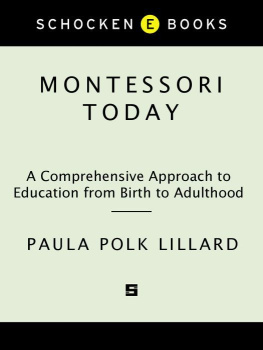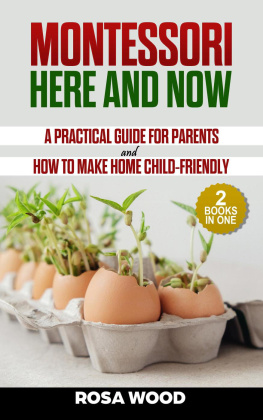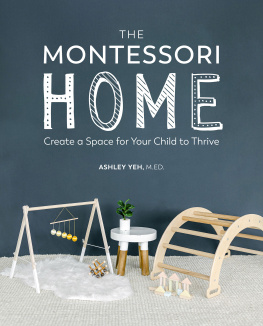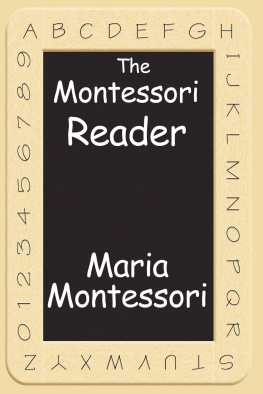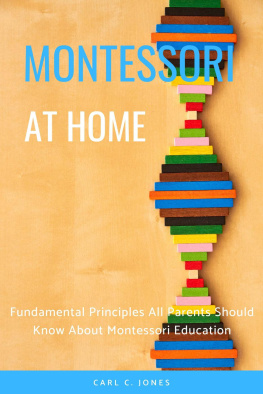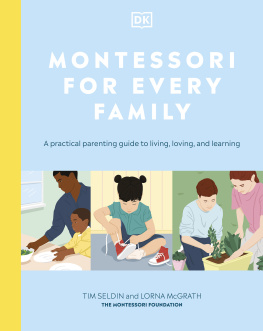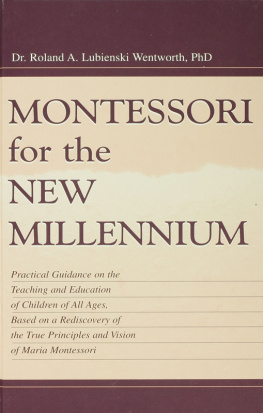ALSO AVAILABLE FROM SCHOCKEN
Montessori: A Modern Approach by Paula Polk Lillard
Montessori in the Classroom by Paula Polk Lillard
Montessori Today by Paula Polk Lillard
Dr. Montessoris Own Handbook by Maria Montessori
The Montessori Method by Maria Montessori
ALSO AVAILABLE FROM SCHOCKEN
Montessori: A Modern Approach by Paula Polk Lillard
Montessori in the Classroom by Paula Polk Lillard
Montessori Today by Paula Polk Lillard
Dr. Montessoris Own Handbook by Maria Montessori
The Montessori Method by Maria Montessori
To John Lillard and Ned Jessen,
the best of Montessori husbands
for their wise counsel and unending
support, patience, and humor
Contents
Contents
Preface
Every morning when they come to school, we greet the children and their parents in the hallway. One spring morning a young mother said goodbye to her two older children at their classroom doors. She then stopped to tell us how much she was enjoying her third baby born just a few weeks earlier. I want to thank you for what you have done [in a course we teach for parents]. When you start off with that first baby youre scared. You have made being a mom fun instead of scary. She paused and looked pensive for a moment, then continued, Not just fun; more interesting and rewarding. You have given me the self-confidence to do this job. I get teary just talking about it. She turned away then, but as she started down the hall, she added in a soft voice, You showed me what to do. Moments like this, and similar ones with other parents who have taken our parent child course, inspired this book.
We are two women, each from a different generation: a mother, Paula Lillard, and a daughter, Lynn Jessen. Yet, we share a common mission in life: to understand childhood and its purpose, and to share this knowledge with parents so that they can help their children reach childhoods goals. We are both Montes-sori primary school teachers, certified to teach children from ages three through six years by the Association Montessori Internationale (AMI), headquartered in Amsterdam, the Netherlands. Additionally, Lynn is an AMI-certified Assistant-to-Infancy teacher, trained to aid the development of children from birth to three years old. Paula holds a Master of Arts degree in Mon-tessori education from Xavier University in Cincinnati, Ohio, and has written three earlier books on Montessori education: Montessori: A Modern Approach (Schocken Books, 1972, highlighting education for children three to six years), Montessori in the Classroom (Schocken Books, 1980, presenting Montessori principles applied to a kindergarten classroom), and Montessori Today (Schocken Books, 1996, describing the Montessori program for elementary education).
Together with Jane Linari, a former colleague of Paulas from Lake Forest Country Day School, we cofounded Forest Bluff School in 1982. Forest Bluff is a Montessori elementary and secondary school for children from eighteen months to fourteen years. Additionally, for the past six years we have co-taught a parent child course at Forest Bluff that focuses on the developmental needs of children from birth to age three. It is this course that the mother was referring to in the hallway that spring day.
Each of us came to Montessori by a different path and at a different time in our lives. To give you further insight into the experiences that led us to Montessori, we would like to share briefly our personal histories. Paula, a mother of five daughters, now a grandmother of eight grandchildren, ranging in age from newborn to twenty-one years, tells her story:
I married soon after graduation from Smith College and raised my children in the 1950s and 1960s. In those days before Betty Friedans The Feminist Mystique, women aspired to be at home as full-time wives and mothers. My generation did undertake significant volunteer work, however, and it was in this capacity that I first became interested in Montessori education. The elementary school that Lynn, age six, and her older sister, Lisa, age eight, attended was beginning a Montessori preschool class. I was skeptical about this old-new educational approach with its emphasis on freedom for children. When the schools principal asked my husband and me to enroll our third child, Pamela, who was then three years old, in the class, I volunteered to be the Montes-sori teachers assistant. I was uncertain about my daughters response to this very different type of education, and my being in the classroom would give me a chance to know firsthand how she was faring. I also wanted to see for myself how it was possible for children as young as three years old to handle freedom in a Montessori classroom. I was a former public school teacher and nothing in my previous experience indicated that young children should be left free to direct their own education.
In the following months, I discovered that Montessori education is about much more than freedom for children. It requires a prepared teacher who understands how children develop and who is experienced in establishing a structured environment that meets their needs at each successive age. The children are not free to do as they like, as I had assumed. Instead, they are free to work: to engage in sustained and productive activity while, at the same time, learning how to behave in a community of others.
Gradually, I began to realize something that I had only suspected might be true when I had my first baby at age twenty-two; there is more to being a mother than just feeding, bathing, dressing, playing with, and loving babies and little children. These little ones under six years old are not miniature beings simply growing larger, as a seed grows into a full flowering plant. They are in the process of forming themselves into new beings through a series of predictable planes of development. For me, being a mother was transformed from largely custodial, albeit loving, care into a stimulating, productive discovery of a new being in formation and how I might aid that process. I was engaged in an intellectual and scientific task of the most immense proportions and significance.
In the ensuing years, modern science has verified that indeed the infant brain is engaged in an extraordinary feat of formation and that the outer environment in large measure determines what that formation will be. This is heartening news. Parents now know that their role is not just important; it is the decisive factor for their childs future. However, there is a dark side to this realization, and we come now to the reason why I am so determined to convey the information in this book to others. Whereas my generation had only one child care bookthe original edition of Dr. Benjamin Spocks Common Sense Book of Baby and Child Caretelling us what to do (and to be honest, we felt free to ignore much of it, having absorbed the wisdom and experience of our own mothers and grandmothers), todays mothers are inundated with thousands of books on child rearing by psychologists and others. This plethora of books, representing so many people with differing backgrounds and experience, gives contradictory advice and too often leads mothers to find themselves in conflicting roles. Add to the confusion over what advice to follow, the guilt so frequently experienced by mothers who work outside the home, and the task of raising children is transformed from a joyful, if challenging, journey of discovery to a tedious and arduous experience.


